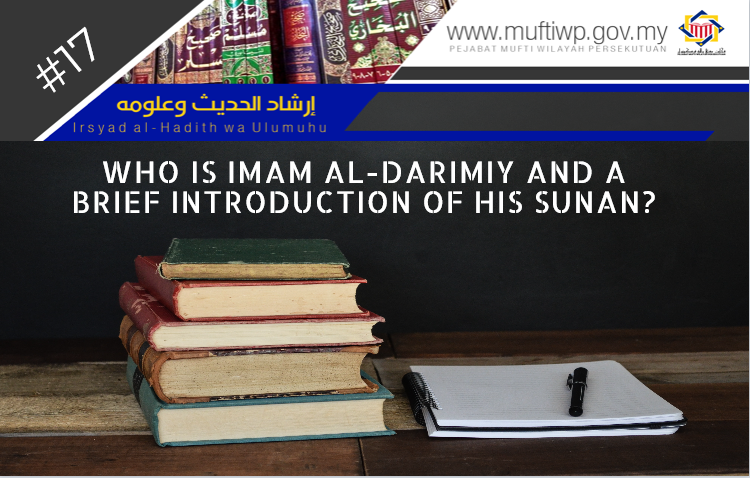Question:
Assalamualaikum. Can you explain about Imam al-Darimiy?
Answer:
Waalaikumussalam.
Alhamdulillah, praise and thanks to Allah for the countless blessings He has blessed us all with. Blessings and salutations to the Prophet Muhammad PBUH, his wives, his family, companions and all those that follow his teachings to the day of judgement.
Sometimes, when we read books on hadith, we would find narrations from al-Darimiy in his Sunan. Thus, it is best if we learn more about this scholar and his methodology in producing his writings briefly:
His name is Abu Muhammad Abdullah bin Abdulrahman bin al-Fadhl bin Buhram ad-Darimiy as-Samarqandiy. Al-Darimiy refers to al-Darim, Uzbekistan. He was born in the year 181 Hijrah and died on the Marwa hill on the day of Tarwiyah. He was buried on Arafah day which falls on a Friday of 255 Hijrah.
Al-Darimiy was blessed with intellect by Allah SWT, he is a critical thinker with a great memory especially in memorizing hadiths. During his lifetime, he always travels in search of knowledge across the globe. Among the destinations which he visited are Egypt, Syria, Iraq, al-Haramain which are Mecca and Medina in Saudi Arabia.
Imam al-Darimi learn from great and renown scholars. He had numerous teachers, among them are:
- An-Nadhr bin Syamil
- Abu An-Nadhr Hasyim bin Qasim
- Marwan bin Muhammad Ath-Thathari
- Yazid bin Harun
- Asyhal bin Haaim
- Aswad bin Amir
- Ja’far bin Aun
In this matter, he also has numerous students who studies under him as well as narrated hadiths from him, among them are:
- Imam Muslim bin al-Hajjaj al-Qusyairi
- Imam Abu Daud
- Imam Tirmizi
- Hasan bin Shabbah Al-Bazzar
- Abu Zur’ah
Opinions of Scholars About al-Darimiy
Imam al-Darimiy is a great hadith scholar famous in his field, thus, numerous scholars praised Imam al-Darimiy, among them are:
- Ibn Hibban once said: “He is among the huffaz (those who memorize hadith) who is mutqin (expert and particular) regarding what hadith he memorized, collected, analyzed, arranged and conveyed.”
- Muhammad bin Nasyar said: “The great memorizer of this world are of four people: Abu Zur’ah ar-Razi, Muslim an-Nasaiburiy, Abdullah bin Abdul Rahman di as-Samarqandi and Muhamad bin Ismail di al-Bukhara.”
- Abu Bakar al-Khilib al-Baghdadi cited this matter in his book Tarikh Baghdad and afterwards it is cited by al-Zahabi, where he said: “He is one of the true travellers in the search of hadith and has a great memory in collecting hadiths through ”
The Status of Sunan al-Darimiy
Al-Ala’iy said: Sunan al-Darimiy is not included in as-Sunan al-Arba’ah in terms of its status but is made as the fifth book, and sunan al-Darimiy is far superior than Sunan Ibn Majah. Due to this, some scholars make is as one of the books of al-Kuttub al-Sittah replacing Sunan Ibn Majah. In it, there are hadith mursal (there is no mention of any Companion in the sanad), Munqati’ (the sanad is broken), Mu’dhal (two or more narrators are missing) and Maqtu’ (discontinuous text of the hadith).
The Advantages of Sunan al-Darimiy
Among them are:
- It is famous among hadith scholars as al-Musnad which is Musnad al-Darimiy.
- The hadiths are arranged according to fiqh chapters.
- Sunan al-Darimiy is beautifully and systematically arranged.
- There are only a few weak narrators in it.
The Methodology of the Arrangement of the Book and the Number of Hadiths in His Sunan
In the muqaddimah of the book, it contains several chapters related to Syama’il of the Prophet PBUH, chapter according to sunnah, chapter on the etiquette of issuing a fatwa and the chapter of the advantages of knowledge. Then, the hadiths in this book are arranged according to feqh chapters beginning with the chapter on purification and ends with the chapter on the advantages of the Quran. There are 3503 hadiths and athar (آثار) in this book.
Conclusion
To conclude, Imam al-Darimiy is one of the hadith scholars which has greatly contributed in the knowledge of hadith for the Muslim ummah and to this day his works are referred to and placed in Muslim libraries. May Allah SWT bless him. Amin.
Wallahua’lam.


